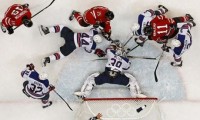1) Swifter, Higher, Stronger
SamuraiK7, “Michael Phelps — Butterfly” (2012)
If you’re looking for citius, altius, fortius, Michael Phelps is your man. He’s the kind of athlete that makes members of the IOC wet their pants. The guy does honour to Zeus. He’d outdo Hermes of Praxiteles any day. Michelangelo spent his years sketching out strong, swift fantasy men who looked just like Phelps. We can only stare in wonder as he flaps his way through the heavy water (Make an exception for Mark Spitz who says he’d have beaten Phelps. Why doubt a man who won all those gold medals while sporting shaggy hair and a moustache? Respect).
Seemingly invincible demi-Gods like Mark Spitz and Michael Phelps and Usain Bolt are, you know, fine and all that. But the true Olympic Moments, the ones we remember, are more about scraping a medal against the odds, snatching a surprise gold; about sacrificing oneself for the team, wincing courageously through the pain; about failing gloriously.
In the words of Pierre de Frédy (aka, Baron de Coubertin), one of the men to whom we owe the modern Olympics: “The most important thing in the Olympic Games is not to win but to take part, just as the most important thing in life is not the triumph but the struggle. The essential thing is not to have conquered but to have fought well.”
2) The Essential Thing
English runner Derek Redmond came into the 1992 Games as one of the favourites to win a medal in the 400m, despite ongoing injury problems. He ran the fastest time in the first round, and claimed victory in his quarter-final race. In the semi-final, he made a strong start. Then his hamstring snapped.
Olympics, “Derek Redmond Crosses Finish With His Father” (Barcelona, 1992)
3) I Had To Do It Anyway, For Me, & For The Team
Japanese gymnast Shun Fujimoto had already injured himself — a fractured kneecap — when he stepped up to perform in the final two events of team competition at the 1976 Olympics. He kept the injury to himself. “The competition was so close and I didn’t want the team to lose concentration worrying about me.” Through shooting pain, Fujimoto got up on the pommel horse and scored a 9.5, and then the rings, one of his strongest disciplines, and scored a 9.7. During the dismount, a triple somersault, he dislocated his already-broken knee and tore the ligaments. “How he managed to do somersaults and twists and land without collapsing in screams,” said one physician, “is beyond my comprehension.”
aingefan22, “Shun Fujimoto” (Montreal, 1976)
Not to forget American gymnast Kerri Strug, who did a Fujimoto at the 1996 Olympic Games, heroically performing a last vault on a twisted ankle so that her team could get the points it needed to win.
4) Five? Don’t Be Ridiculous
Rowing is one of those especially gruelling sports that involves absurdly long cardio vascular workouts and punishing resistance training, not to mention unwavering discipline at the dinner table. Slacken off for a moment and you’ve lost your edge. So get this. In 1996, Sir Steven Geoffrey Redgrave CBE DL and 2011 BBC Sports Personality Of The Year Lifetime Achievement Award Winner, took gold in his fourth straight Olympic Games. That’s right, he’d already won gold in 1984 and 1992, and bronze in 1988. This is a man who for years battled severe back pain, ulcerative colitis and other anti-sport infirmities, including diabetes mellitus type 1, diagnosed in 1997.
As you’d expect, with a fourth Olympic Games under his belt, and Brits going gaga over his successes, he was ready to move on to other things. “Anyone sees me go anywhere near a boat, you’ve got my permission to shoot me.” Yet four years later in Australia’s Penrith Lakes, he could be spotted in a coxless four, lining up for one final medal attempt.
A medal was anything but a sure thing. At the World Cup Regatta in Lucerne a couple months before the Olympics, his team had lost to the Kiwis in the semi-final and come fourth in the final behind Australia, Italy, and New Zealand. Pre-final races had not been all that convincing either.
The Italians established an astonishing 44 strokes-per-minute pace. Surely there was no way a human being — a 38 year-old diabetic human being — would find the strength in himself to become an Olympian one more time.
Olympics, “Steve Redgrave & Matthew Pinsent” (Sydney, 2000)
5) The Sad Colussus
Another diabetic athlete who overcame personal hardship to claim victory in the most glorious and moving fashion is weightlifter Matthias Steiner. Steiner went into the clean and jerk stage of the 2008 weightlifting competition in fourth place. He did poorly in his first attempt, failing to lift 246kg — to date, his personal best. He made the lift on the second attempt and moved into third place. But then his Russian opponent Evgeny Chigishev took a seemingly unassailable lead with a 250kg lift. To overtake Chigishev and win gold, Steiner would have to make a 258kg lift, 12kg more than he’d ever lifted. “I was fairly certain I could do it, but there were some doubts… I was going to go for it at all costs, even if it meant breaking all my bones.”
Know that Steiner’s wife Susann had died in a car accident only one year earlier. In his grief, Steiner lost 8 kilos and a whole lot of his focus before battling back to get fit in time for the competition.
You can watch his gold medal lift in the home video below. His exultation is cut short, but in that first instant witness sorrow and joy pour from him in equal measures.
damojkelly, “Matthias Steiner 258kg Clean & Jerk (Beijing, 2008)
Standing on the gold medal podium, Steiner kissed a photo of his wife. “Beijing was her dream too. For me it was only right to have her at my side during that moment.”
6) Surprised By Victory
Surprise victories are always lovely, and it’s all the more charming when the victor is as surprised as anyone else.
Olympics, “Women’s 800m Final” (Athens, 2004)
Kelly Holmes has her own story of personal struggle. Training for the 2004 Games, she was managing a severe depressive disorder along with a series of injuries, and at one point considered suicide. Medical help and non-banned herbal serotonin tablets got her to the games where she’d planned to compete in the 1500m. Once in Athens, a few people talked her into running the 800m as well. Good job they did. She got gold in both races!
7) The Last Of The Flying Finns
Two middle-distance runners collide and fall off the track during the 10,000 metre final. One stays down, his race is over; the other gets back up, catches the pack and wins gold, breaking the world record. That second runner was Lasse Virén of Finland, a man who entered the 1972 Munich Games as a dark horse and left a legend, with two gold medals around his neck (he also won the 5000 metres). In this video, you see an older Lasse Virén fidgeting as he relives the most glorious moment of his athletic career.
miniilo, “Lasse Virén, 10,000m Final” (Munich, 1972)
8) As If The Accident Had Never Occurred
That’s the kind of grit we like to see, getting up after a fall. Or after a knock to the back of the head. In the preliminary rounds of the 1988 springboard diving competition, Greg Louganis whipped his head into the diving board during a reverse two-and-a-half somersault pike. He suffered a concussion and had to have his head sewn up. 22 minutes later, he stepped up to do a similar dive to the one he’d just failed to execute: a reverse one-and-a-half with three and a half twists. Ballsy. He went on to win gold. A couple days later, he won the platform competition as well, but only by executing the “dive of death.”
gregorylouganis, “Greg Louganis: 16 Days of Glory” (Seoul, 1988)
9) They Sent Me To Finish The Race
Ryeberg has strayed a little from “failing gloriously.” The marathon — flagship sport of the Olympic Games and always the last event on the athletics calendar — provides us with plenty of examples. Think of Mexico City, 1968. The winner had crossed the finish an hour earlier. The closing ceremonies were over and most people had left the stadium. In hobbled John Stephen Akhwari of Tanzania, bandaged and bloodied. He’d fallen at the 19km mark and badly hurt his knee and shoulder, but he chose to carry on to the end. Tearful applause please.
abundanceteachers, “Finish The Race: Personal Story Of Courage” (Mexico, 1968)
10) Decorate This Arch With Triumph
Abebe Bikila joined the Ethiopian Olympic team just as the plane was about to fly to Rome for the 1960 Games. Ethiopia’s marathon runner Wami Biratu had broken his ankle playing soccer and needed a last minute replacement. So they called up Bikila, who also happened to be a bodyguard for the the Ethiopian Emperor, Haile Selassie. Bikila didn’t have running shoes. His plan was to pick up a pair in Rome from the Adidas shoe stand (as sponsors of the Games, Adidas was providing shoes for athletes), but there weren’t any left that suited his feet, so he decided — the story goes — to run the way he had always trained: barefoot. Fellow runners scoffed, and you can only imagine how derisory local Romans found this barefoot running. Bikila won gold. In this beautiful, cinematic footage, see the great runner reach Rome’s triumphal Arco di Constantino.
History Channel, “Abebe Bikila’s Barefoot Win” (Rome, 1960)












